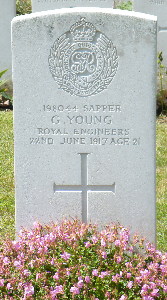
Level Crossing Cemetery Fampoux
Pauline Priano has submitted the following:-
George Young was born at Wardley Colliery, County Durham in 1896, one of 10 children of whom only 8 survived, 6 sons and 2 daughters. His father William Young was born at Pit Row, County Durham in 1861, he married Eliza Kelsall born 1863 native of Sunnybrow, County Durham at Shincliffe in 1881. By 1891 they had moved to 21, The Square, Heworth, near Gateshead where William worked as a coal miner, joined later when they were older by his three elder sons, John (19) an onsetter, Edward (17) a putter and William (15) a driver. At the age of 15 in 1911 George too worked at the colliery as a screener, his father was now a deputy and they occupied a four-roomed house at 29, Third Street, Wardley Colliery.
George Young enlisted at Sunderland and was first assigned as 49949 Royal Garrison Artillery later transferred as Sapper 198044 Royal Engineers 184th Tunnelling Coy. During 1915 the British tunnelling companies were formed in response to the fact that the British Expeditionary Force at the Western Front had discovered the Germans were mining to a planned system, something that the British had failed to do. Kitchener and the French field marshals investigated the possibility and suitability of forming British mining units and the idea was approved and the scheme initiated February 19th 1915. To make this work quicker and safer the British Army enlisted experienced coal miners, many of whom were outside the normal recruitment age policy. The 184th Tunnelling Coy was formed at Rouen in October 1915 and sent immediately to the Somme for work at Maricourt. By spring 1916 they were active in the Vimy Ridge sector where some 70 mines were fired. May 1916 a German infantry attack which pushed the British back 700 yds (640 metres) was aimed at capturing the shaft entrances however from June the Germans withdrew their miners to work on the Hindenburg Line and to work in coal mines in Germany allowing the British to construct strong defensive underground positions to support a largescale attack at Vimy ridge.
Before the Battle of Arras, April 9th-May 16th 1917 the 184th Tunnelling Company was engaged in Arras on Fish Avenue Tunnel and in helping with the construction of emplacements for heavy mortars.
The British forces controlling Arras had decided to re-use the ancient underground quarries in the town to aid a planned offensive against the Germans, whose trenches ran through what are now the eastern suburbs of the town. The underground quarries were to be linked up by tunnels so that they could be used both as shelters from the continuous German shelling and as a means of moving troops to the front in secrecy and safety. From October 1916, the tunnelling companies of the Royal Engineers and been constructing tunnels for the troops focusing on Camiere Wellington, a former underground quarry in Ronville near Arras. The New Zealand Tunnelling Company had carried out a first explosion of the underground quarries in Ronville and Saint-Sauveur districts of Arras, November 5th 1916. While the New Zealanders were moving into place, the 184th Tunnelling Company began work on the construction tunnels at Saint-Sauveur November 25th 1916. The scale of the explosion was enormous, in one sector alone four Tunnelling Companies of 500 men in each worked around the clock in 18 hour shifts for two months. By the end of January 1917, the Royal Engineers had constructed 20 kilometres of tunnels linking underground quarries of Arras. The tunnel system could accommodate 24,000 men and was equipped with running water, electric light, kitchens, latrines, a small power station and a medical centre with a fully equipped operating theatre. 184th Tunnelling Company moved to Nieuwpoort in June 1917 and worked on underground shelters along the coast to De Panne in Belgium.
Sapper 198044 George Young Royal Engineers was killed in action 22nd June 1917 and interred at Level Crossing Cemetery, Fampoux, Pas de Calais, France, grave I. C. 36. He was 21 years old and single.
His father William received all monies due to him and his awards of the British War Medal and Victory Medal sent to him at 66, Waggonway Street, Wardley Colliery, County Durham. William Young died in 1925, aged 64 years at Heworth, Gateshead, County Durham. Details of mother unknown.
In Godís safe keeping. Rest In Peace.
George Young is remembered at Heworth on H92.03

